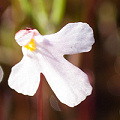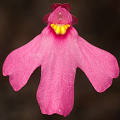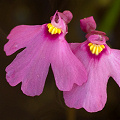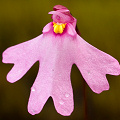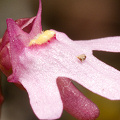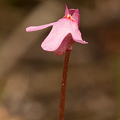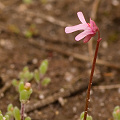| Utricularia section Polypompholyx | ||
|---|---|---|
| Species | Range | Habit1 |
| U. multifida | Australia | T |
| U. tenella | w Australia | T |
| 1T=terrestrial. | ||
Q: About Utricularia subgenus Polypompholyx section Polypompholyx
A: This small section of Utricularia contains species which are
often considered the most primitive in the genus. The reason for this is, in part, because they have four sepals (or, as
more commonly referred to in the genus, "calyx lobes"). This character may be a bridge between the other genera
in the family (Genlisea and Pinguicula) which have five sepals, and
the species in Utricularia which have two sepals (and which are probably more
derived). The lower "sepal " of the species in
section Polypompholyx actually consists of two fused sepals, hence the reduction of
five sepals to four. The interesting bladder structure may actually suggest that the plant functions as a lobstser pot trap, and not
the suction trap more typical in the genus.
There are no differences between my treatment of this section, and the treatment by Ellison & Adamec (2018).
The two species in this section are commonly called "fairy aprons" or "pink petticoats," revealing an
Australian fascination with undergarments and lacy underthings. I shall discuss this with some of my Australian friends.
Utricularia multifida is larger than U. tenella, but these two species can
approach each other in size. The most reliable way to tell them apart is spur size---the spur of little
U. tenella is about as long as the lower corolla lip, while the spur of
U. multifida is much shorter than the lower lip. Also, while the lower corolla lip of
U. tenella is divided into three lobes, the lower lip of U. multifida
is often (slightly to moderately) further split into a total of four to six lobes. Be careful using that method, though; you can see that
the lower lip of the white flower variant on this page is not at all 6-lobed.
Plants in this section (along with plants in section Tridentaria)
were once considered a separate genus, i.e. genus Polypompholyx. However, Taylor clearly argued
for the case of placing these plants into mere sections of the genus Utricularia.
As Slack pointed out, the subgenus name is a lot of fun to say, so I am glad it hasn't gone away entirely.
Molecular work indicates that this plant should be grouped with its long-associated section
Tridentaria and also the two-sepaled section
Pleiochasia, in a newly expanded subgenus
Polypompholyx. That pretty much kills any residual argument that the plants should be a separate
genus because of the four-sepals-argument.
The plants in this section are difficult for me to grow. They are annuals, and while I have had the best luck with
U. multifida, I have never obtained enough seed to carry it to a
second season. Utricularia tenella is also occasionally tried by
horticulturists, but to my knowledge no one has had lasting success.
Page citations: Müller, K., and Borsch, T. 2005;
Reifenrath, K. et al. 2006; Rice, B. 2006a;
Slack, A. 1986; Taylor, P. 1989; personal observations.
